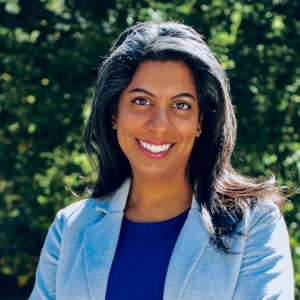BINA M. PATEL
BINA M. PATEL
Saathi Impact Consulting
CEO
PLACES Facilitator
PLACES 2012 Cohort
 As a child of immigrants, Bina Patel has found a way in her daily work to honor her family’s roots.
As a child of immigrants, Bina Patel has found a way in her daily work to honor her family’s roots.
“My parents, my grandparents and my ancestors are a big part of how I see the world,” said Patel, whose family hails from various parts of India, most notably the coastal city of Mumbai, formerly known as Bombay. “I’m very thankful my parents made space for us to know our culture and traditions.”
Growing up, Patel said she had to tackle the “model minority” myth of how Asian-Americans are perceived — that of a group that is studious, polite and self-reliant — and it’s something she still encounters when she’s teaching about racial equity and anti-racism.
Patel said she feels at most first encounters, she’s usually given a “pass” in predominantly white spaces.
“I show up, and because I’m brown in white spaces, I’m credible. But because I’m not black, I’m not threatening,” said Patel. “But when I say things about white supremacy in these very white spaces, then I’m too brown.”
Patel is not only a PLACES alum, she is also one of the fellowship’s lead facilitators — known for helping create a space for fellows to feel both safe enough to share, yet challenged enough to grow. She said her experience building her consulting company and teaching sessions around an- ti-racism has meant learning to be comfortable speaking about uncomfortable truths.
“I say what needs to be said,” said Patel, formerly of the Grand Victoria Foundation in Illinois. “I don’t censor the information, but as a facilitator I find different way to bring it forward.”
Why did you get into philanthropy?
Philanthropy has tremendous power to do better and to do good. And it has a long legacy in this country’s history around wealth, dignity and justice.
Issues of justice and identity and wealth — they all live in this sector.
You were a PLACES fellow. What was that experience like and how has it impacted your work?
What has stayed with me most from the fellowship: The need for organizational change. It’s not enough that I had the amazing experience and learned so much. Figuring out how to bring others along in the journey was important in order to catalyze change in the foundation.
I love that I am still in touch with fellows from my class, and we’ve stayed connected as friends, colleagues and thought partners.
What is one of the biggest challenges you’re facing right now in this work?
The idea that racial equity is “sexy” right now and in a couple of years it’ll go away and the work will still not be done. People often say, “We hired a consultant, did a year of training, we have a strategic plan — aren’t we done?”
How do we sustain this work when it is clearly “not done”?
What’s next when this work is not done? Are we really naming what our real problems are, or just using coded language to make it comfortable?
How are you building for equity?
One of the most frequent feedback I get is, “We really want to stop talking about it and get to work.” What I realized is that when you do this work, and you don’t talk about white supremacy and whiteness, you’re not giving them the truth.
When we say “racial equity,” you close your eyes and you see black and brown faces. This isn’t a problem of black and brown, it’s whiteness and white supremacy. And I’ve found that there are white people who are willing to talk about it. If we create a space that’s about justice, everyone can come into it.
If you could write a very short letter —“Dear People In Philanthropy…” What would it say?
Dear People in Philanthropy,
Reimagine the future. Reimagine what’s possible. Examine the world around you and what you practice differently.
Get fixated on humanity and the collective good. And ask yourselves, what are you withholding? And who are you protecting?
Is there an internal question you’re constantly asking yourself while doing this work? What is it and how do you answer it?
Who am I in service of today? That’s my question.
My dad, since I was about 6 or 7, would ask me, “Are you helping people?” He instilled in me the purpose of helping people.
Am I helping people find joy? Am I helping people find healing? Am I helping people be healthier?
People who are told they don’t belong here, people who are traditionally marginalized: those are my people.
